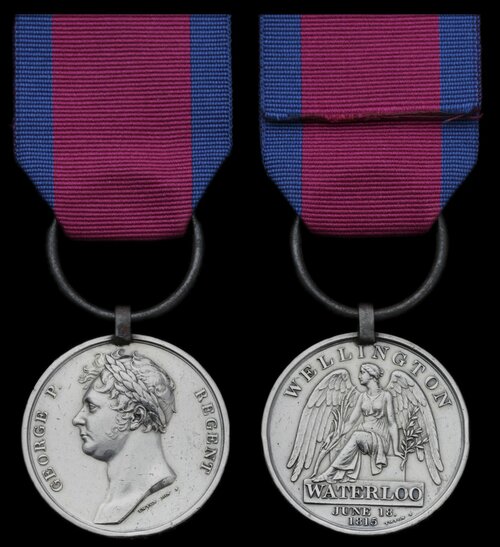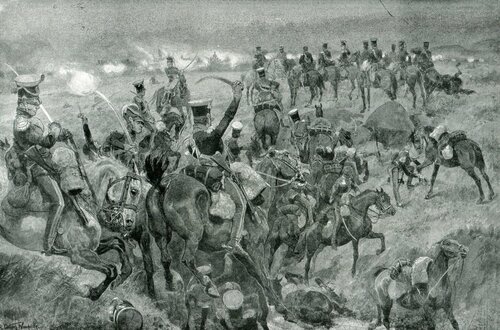Auction: 22001 - Orders, Decorations and Medals
Lot: 15
The Waterloo Medal awarded to Lieutenant George Dodwell, 23rd Light Dragoons, who participated in the regiment's famous - and very costly - charge at the Battle of Talavera in 1809, and saw much action during the Waterloo Campaign
Waterloo 1815 (Lieut. George Dodwell, 23rd Reg. Light Dragoons), fitted with original steel clip and ring suspension, some light edge bruising and contact marks, otherwise good very fine
George Dodwell, of Kevinsfort, County Sligo, was appointed Cornet in the 23rd Light Dragoons on 6 July 1804, and promoted to Lieutenant on 25 April 1805. He served in the Peninsula from June to December 1809, and was present at the Battle of Talavera where the 23rd Light Dragoons made their famous and costly charge against three lines of cavalry. Sir William Napier, the renowned military historian and army officer noted in his account of the battle: ‘Sir Arthur ordered Anson's brigade of cavalry, composed of the 23rd Light Dragoons and the First German Hussars, to charge the head of these columns [Villarte's Division, some grenadiers and two regiments of light cavalry]. They went off at a canter, increasing their speed as they advanced and riding headlong against the enemy; but in a few moments, a hollow cleft which was not perceptible at a distance intervened, and at the same moment the French, throwing themselves into squares, opened their fire. Colonel Arentschild, commanding the hussars, an officer whom forty years’ experience had made a master in his art, promptly reined up at the brink, exclaiming in his broken phrase, “I vill not kill my young mans!” The 23rd found the chasm more practicable, the English blood is hot, and the regiment plunged down without a check, men and horses rolling over each other in dreadful confusion; yet the survivors, untamed, mounted the opposite bank by twos and threes’... and ‘fell with inexpressible violence upon a brigade of French chasseurs in the rear. The combat was fierce, yet short, for Victor seeing the advance of the English, had detached his Polish lancers and Westphalia light horse to support Villatte, and these fresh men coming up when the 23rd, already overmatched, could scarcely hold up against the chasseurs, entirely broke them.’
After this, the unstoppable 23rd rode on to attack French infantry, which (unfortunately for the cavalry) had time to form squares - an almost-impregnable defence against mounted opponents. Major Ponsonby of the 23rd, somewhat absentmindedly, later wrote: ‘We had a pleasing amusement of charging five solid squares with a ditch in their front. After losing 180 men and 222 horses, we found it was not agreeable and that Frenchmen will not always run away when they see British cavalry...’ The fighting now petered out. It had been a very bloody battle. The grass on the battlefield caught fire, roasting the dead bodies of men and horses and scorching the wounded. ‘I never saw a field of battle which struck me with such horror as Talavera’, wrote George Napier, another member of that famous military family.
The 23rd Light Dragoons, with a total strength of 480 officers and men, lost 207 killed, wounded and missing - and 224 horses. Such a large 'Butcher's Bill' was impossible to immediately replace and the regiment was withdrawn to England to recruit, never to return to the Peninsula. George Dodwell’s brother, James, was also serving with the regiment at Talavera and was slightly wounded/injured in the action.
Back into Action
On 16 June, the 23rd were rushed up from Brussels to Quatre Bras and the following day were employed with Dornberg's 3rd Cavalry Brigade in covering the retreat of Allied troops. At Waterloo, the 23rd Light Dragoons were posted in the rear of Halkett's 5th Infantry Brigade in the Allied right centre, and during that long and dangerous day made several important charges with a high degree of ‘steadiness and determined bravery’. Between five and six o'clock, Cox's Troop was detached from the main body of the regiment and successfully repulsed and pursued a body of French cavalry causing annoyance to a brigade of guns, until repulsed by the fire of a French infantry square. In the evening as the triumphant Allied advance began, Lord Uxbridge rode up to Major Lautour, commanding the 23rd, and requested a troop horse, his mount being wounded or exhausted. Latour immediately complied ‘by dismounting Sergeant-Major Stride, giving his Lordship the Sergeant-Major's mare.’ The grateful cavalry commander instantly galloped some yards to the front to join Wellington and was busily engaged in urging the troops not to let the enemy stand when the cannon ball struck him in the knee, giving rise to their famous exchange: ‘By God, sir, I've lost my leg!’, ‘By God, sir, so you have!’
Dodwell was placed on half-pay on 30 May 1816 and appears to have returned to his native Ireland, where he died on 23 June 1843.
As an additional point of interest, the National Army Museum in Chelsea holds the Regimental Guidon of the 23rd: it is believed to have been carried by the regiment at Talavera, probably the last occasion on which a cavalry guidon was carried into action by a British cavalry regiment.
Subject to 20% VAT on Buyer’s Premium. For more information please view Terms and Conditions for Buyers.
Sold for
£3,800
Starting price
£3200







